|
The Bead SiteHome>Beadmaking & Materials>Glass Beads Made in Africa: Kiffa Beads
Glass Beads Made in Africa:
Part Two, "Kiffa Beads"
With only two exceptions (Egypt and Bida, Nigeria), there has been no traditional glassmaking in Africa. However, that didn't stop inventive Africans from making glass beads. They did so by recycling glass, crushing it into a fine powder and making beads from the powder.
|
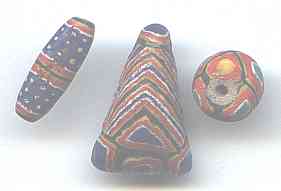
|
One of better known of these beads are called "Kiffa beads" in the West, after a large town in Mauritania were some were made. Historically, they are very important, as the technique is around 1000 years old.
The women who make them first crush glass into a fine powder between stones. Plain glass, such as that used for bottles, is formed into a core. Brightly colored opaque glass will be used for the decorations.
Doner: Anita Gumpert.
|
|
The core glass is wet with saliva and built up into a bead shape upon a thin stick. At right is the "frame" used for the triangular pendants that are commonly worn three at a time in the hair. The inner stick remains in the bead, while the one protruding from the bead will burn out and leave the perforation.
The core is shaped in a shell or in a small clay mold.
From Mauny 1949: 111, fig. 16.
|

|
|
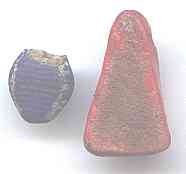
|
Once the core is formed, the other colors of glass are wet and placed on the core with a pin or needle. The blue bead at left will be used on bracelets. This broken specimen is an older one, as it is made of two shades of blue alternating in stripes. The all-red triangular pendant is shown at its back side.
Doner: Rudy Schneider
|
|
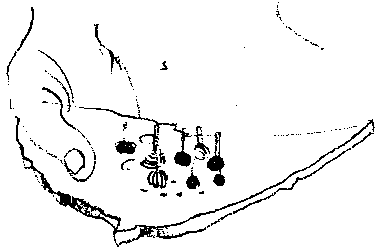
|
The finished beads are then placed on a piece of broken pottery to be fired (Gabus 1982: 144, fig. 2; drawn by Walter Hugentobler).
The decoration of beads such as those at the top of the page is the most time-consuming part of the operation. A woman can only make about three beads like these in a day.
|
|
Firing is done on a bed of charcoal. The potsherd is placed upon it and a cover put over the beads (often a sardine can). Firing takes about 45 minutes.
From Gabus 1982: 144, fig. 4; drawn by Walter Hugentobler).
|
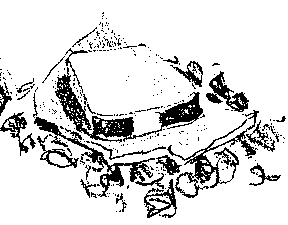
|
|
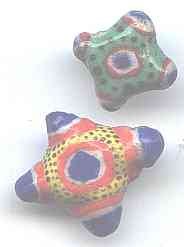
|
The small-scale industry declined in the 1980s, but interest in the beads in the West prompted a number of women to take the work up again. Many of the newer beads are garish or poorly made. These crosses (with no religious affiliations) were made in the late 1990s (they seem no longer to be made) and, while not as fine as some earlier beads, do require considerable skill.
Donor: David Nevill
|
|
Historically, the most interesting aspect of this beadmaking (wet-core powder-glass)
is its considerable age. French excavations led by Roberts (1970) at Tegdaoust, Mauritania discovered beads made this way and clay molds for them (see below),
published by Vanacker (1984). Some mold fragments were found dating to the 9th century, but most dated to the 10th to 12th centuries.
|

|
Tegdaoust is assumed to be the ancient city of Aoudaghost, described by Muslim North Africans beginning in the 9th century.
It was originally a city of ancient Ghana (crosshatched on the map) and later located in ancient Mali (vertical lines), which absorbed Ghana.
Modern Mali takes its name from the ancient kingdom, as part of it was in the Kingdom of Mali. Modern Ghana has nothing to do geographically with the Kingdom of Ghana. From Francis 1993.
|
|
Below are drawings of two wet-core powder-glass bead molds reconstructed from fragments found at Tegdaoust, Mauritania. Source: Vanacker (1984: 48).
|

|

|
|
Aside from being a focus of collecting and writing, "Kiffa beads" live on as an icon in the bead world. These porcelain examples were made by Howard Newcomb for the Third International Bead Conference held in Washington DC in1985. The arrangement is similar to that used by Mauritanian women.
Donor: Howard Newcomb
|
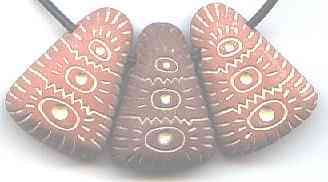
|
|
Part 1: Bida, Nigeria - Part 2: Kiffa and Wet-Core Beads -
Part 3: Dry Powder-Glass Beads in Ghana
Some References:
Gabus, Jean
1976 Oualata et Gueïmaré des Nemadi. Neuchâtel: Musée d'Ethnographie.
1982 Sahara Bijoux et Techniques. Neuchâtel: Baconniére
Mauny, Raymond
1949 Fabrication de Perles de Verre en Mauritanie. Notes Africaines 44: 116-117.
Opper, Marie-José and Howard Opper
1989 Kiffa Beads: Mauritanian Powdered Glass Beads. Alexandria VA: Opper and Opper.
Nevill, David
2002 A Toubab in the Desert - A Trip to Kiffa, Mauritania.
Bead Society of Great Britain Newsletter 64: 2-5.
or on the Web: http://www.toubab.com/Contents/The_Kiffa_Trip/the_kiffa_trip.html
Robert, Denise S.
1970 Les Fouilles de Tagdaoust. Journal of African History 9(4): 471-493
Vanacker, Claudette
1984 Perles de Verre Decouvertes sur le Site Tegdaoust (Mauritanie orientale).
Journal des Africanistes 54(2): 31-52.
__________________________________________________
Small Bead Businesses | Beading & Beadwork | Ancient Beads | Trade Beads
Beadmaking & Materials | Bead Uses | Researching Beads | Beads and People
Center for Bead Research | Book Store | Free Store | Bead Bazaar
Shopping Mall | The Bead Auction | Galleries | People | Events
The Bead Site Home | Chat Line | Contact Us | Site Search Engine | FAQ
|










